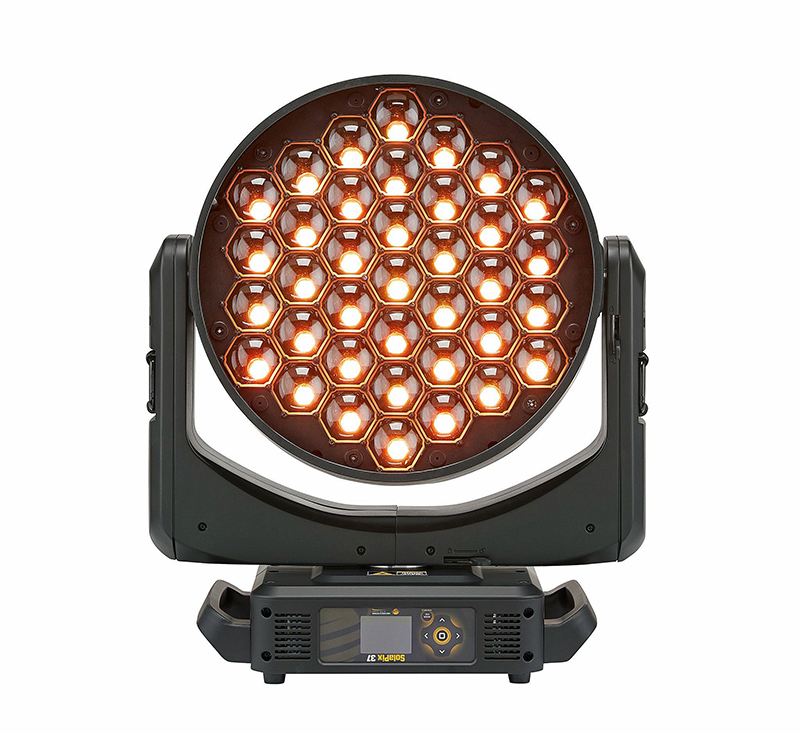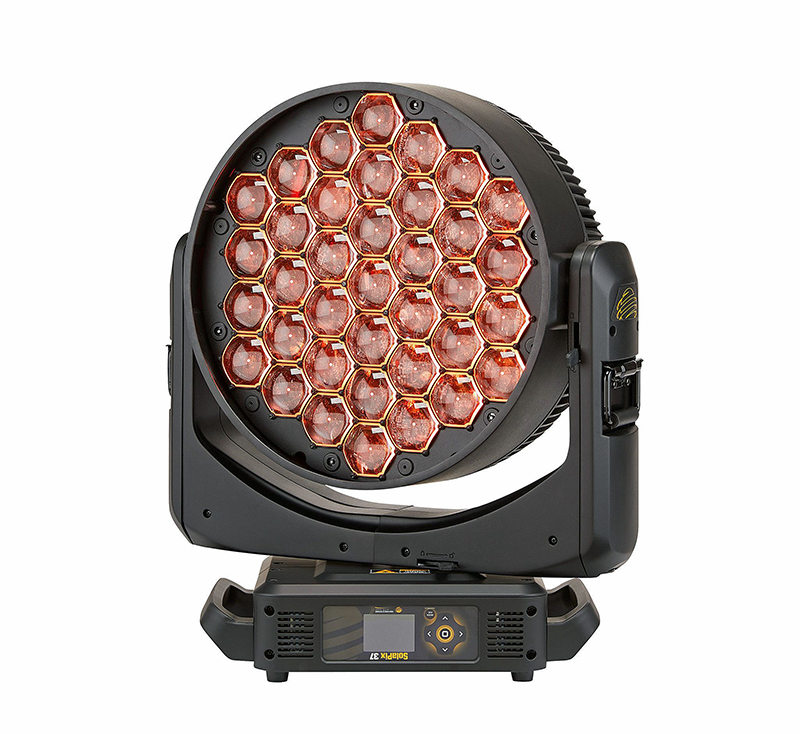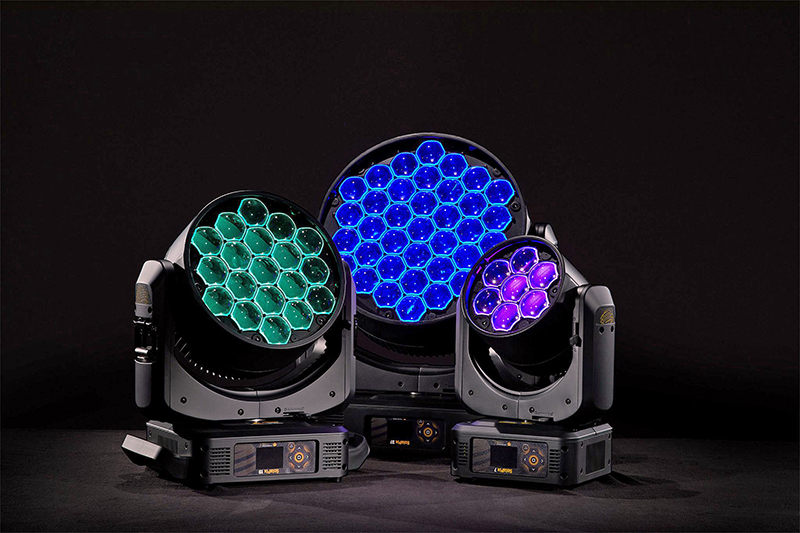
High End Systems rolled out their SolaPix 7 and SolaPix 19 wash light luminaires last year to high accolades. With their latest release of the SolaPix 37, they have unleashed a great large format wash fixture for any designer’s toolbox, offering 37 individual cells of light with many effects onboard.
Previously, High End Systems had unveiled their TurboRay fixture, which was a great small-format wash light with some interesting effects of its own. At the time I reviewed that fixture, I asked why High End did not manufacture a multiple cell open-faced model as every other manufacturer had. Their reply was simple. “Oh, we are, but we are waiting to do something special with this type of fixture, something that can add some innovation to these models.” I’m here to tell you they have lived up to their words, and this light packs a lot of potential.

Hardware and Attributes
The first thing I notice is that this is the first fixture I have seen to offer up this many LED cells that is not ginormous in size; yet it’s still fairly big. The front face of the 37 individually controlled pixels is only 16 inches wide with some thin yokes attached either side. The yokes offer collapsible handles in addition to the open handles on the base for easy mobility of this 52-pound fixture. The footprint of this fixture is compact — about 20-by-10 inches — and it measures less than two feet in height, yet it throws a powerful punch with 29,000 lumens being emitted with all colors at full.
The light source consists of 37 separate 40-watt RGBW 4-in-1 Osram Ostar LEDs. They are arranged in the best formation I have ever seen for symmetrical chasing, with the individual lenses compacted in place by something High End is calling their “HaloGraphic Pixel Definition.” Basically, each of the 37 cells is six sided and has the edges of the lens diffused themselves, to a honeycomb look. The edges absorb the light being emitted from each cell, giving this fixture some unprecedented eye candy that can really make this flat faced LED fixture come alive and stand out from the rest.
There is no protective lens on the front, nor does this fixture need one. From the side, one notices the depth of the head is barely wider than seven inches. This baffles me, as the zoom range for this fixture is incredibly huge, going from a 4.5° up to 60°, which is about a 13:1 ratio. I notice that at a tight zoom, the beam emitted is close to that of a hard edged light. As soon as one zooms out, the edge softens nicely, with minimal halation.
High End has been known to use their patented defogger system on the lens of all their Sola products, but in this case, it wasn’t physically possible due to the fact that these lenses are not made of glass. But because of how valuable this function still is, High End developed a special patent-pending coating for the lenses to prevent haze from settling on them. This helps the lenses to stay clear for longer and helps to enhance the face look.
The color system appears to give me nicely saturated colors, consistent with other High End products. There’s a separate channel for adjusting the overall color temperature as well, which ranges from 2800K to 8000°K.
The dimming itself is 16-bit and, to the eye, smooth as can be. Various electronic strobe functions are available as well. I found the strobe functions to be very clever. They include synchronous/all Cells strobe simultaneously, random/all cells strobe simultaneously, at random intervals, random pixel/each pixel strobes randomly, and random pixel/color, where each pixel strobes at random, in random colors.
Movement wise, the fixture turns smoothly, and quick enough for its large format size. It can pan 540° and it takes 2.5 seconds to rotate a full 360°. Users can hang this fixture at any angle with the two Omega clamps (included), and it will not lose its focus coordinates.

Control
As with any multi-part fixture, it can take a few minutes to wrap your head around how this fixture needs to be programmed and how the user wishes to operate it. The SolaPix 37 can utilize up to 186 DMX channels at its most extended mode, but it’s best to break down how users would operate this device. The first part of the fixture is called the Base. It consists of 21 channels of basic moving light control, including movement, zoom, dimmer, strobe and control. There are also separate RGBW color controls for the whole face.
Adding to that are two more “modules.” The Pixel Module consists of 148 channels or individual RGBW color control for the 37 cells behind the lenses. This module gives the user individual control of each cell. Consoles these days are able to assign virtual dimmers to each of the 37 cells, and ETC/HES chose to go that route as well. Users still have the intensity fader (dimmer) on the base if they wish to just turn the whole face on at once.
The last one is the FleX Module. This is an onboard effects engine that currently consists of 17 channels of built-in macros and ways to manipulate them. The basic default setup for the fixture is to just use the base and FleX Modules. That gives you fewer channels, but you still has the onboard effect macros. Users have the option of just using the Base and Pixel Modules and bypassing the FleX if they want. Most experienced programmers will run the full mode with all modules. The control channel on Base chooses the priority for which layer of control is “on top.”

The FleX Module is the time-saver that many will turn to, especially if they do not have sophisticated layout views on their desk of choice to facilitate programming. It’s hard to refer to these effects as macros, because they really do so much more than you would expect. For instance, look at the chart on this page (Fig. 1), which simulates how one of the effects moves across the face of the pixels.
Once the user selects any macro they wish to run, they can then manipulate the speed and direction of the macro (how fast it goes from one step to the next step), the fade of the macro (i.e., does it snap from step 1 to step 2, or does it fade, and how fast?). On top of that, users control each of the four different colored areas on the drawing. Each area has the following settings available: Intensity, RGBW color mixing and strobe control. The Blue area, meanwhile, has all of the abilities listed above, but also has additional abilities like the ability to mask what sections are on vs. off. In other words, I can make the whole face red, then run an animated effect of clock hands circling in white and strobing if I wish. It’s a whole lot of fun to play with, and more effects are scheduled to be added to the fixture later this year.
The SolaPix 37 has a unique addressing scheme, which allows the three modules of the fixture to be addressed anywhere over DMX, sACN or Art-Net. In relation to pixel mapping, users can feed their mapping signal in from a console using DMX through the XLR connectors and any console’s onboard pixel mapper or feeding a video signal through the Ethernet connection, if desired.
The fixture is solidly built, with an aluminum frame and a black ABS shell that is easily removed with some quarter turn screws for cleaning. The colored LCD screen/user interface is easy to manipulate and is battery-operated for addressing without any power. The PWM can be set at levels between 2.4KHz and 16KHz to avoid any camera flicker instances. Any voltage from 100-240 AC can operate the fixture, which utilizes a maximum of 1500 watts. The fixture can be purchased with a two-slot road case as well.
At a Glance:
A Honey of a Wash Fixture
The SolaPix 37 is a bright wash fixture with a wide zoom range and lots of good strobe options. It gives users a splendid pixel arrangement with a honeycomb look with diffused lens edges, a fun FleX Module bag of tricks, and great strobe effects in a large format (yet surprisingly compact) fixture.
PROS: Bright wash fixture, wide zoom range, good strobe choices. Easy to program for a multipart fixture, with FleX effects. Great eye candy with the company’s unique HaloGraphic Pixel Definition.
CONS: The face of lenses does not rotate itself.
SPECS
- Lamp Source: 37 Osram Ostar 40W 4-in-1 LEDs
- Color System: RGBW mixing
- Total Wattage: 1,500 watts
- Power Draw: 19A at 100V, 7.8A at 240V
- Zoom Range: 4.5° to 60°
- Pan range: 540°
- Tilt range: 258°
- PWM Range: 2.4KHz — 16KHz
- Dimensions: 23.7 x 20.3 x 10.4” (HxWxD)
- Weight: 52 lbs.
- MSRP: $6,800 (without road case)
- Manufacturer: High End Systems
- More Info: www.highend.com


